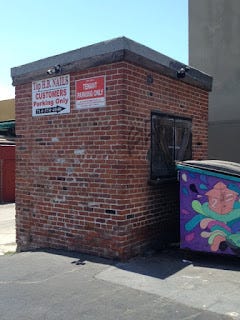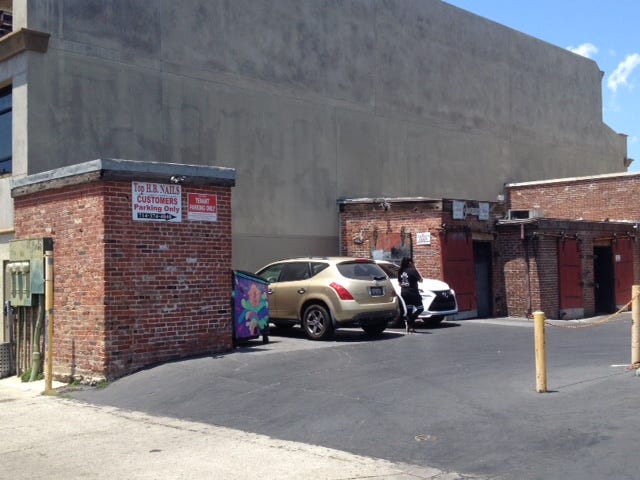History: The old 1920's jail cells in downtown Huntington Beach
A little piece of the early history of H.B. is still there, tucked away in an alley downtown
Here are three of the four 100-year-old old jail cells, remaining from the 1920’s era. These are just off of the alley, right behind the Longboard bar on Main Street, and are used for storage for a local business these days. #steveemigphotos
Back in the late 1800’s, a couple of guys had an idea. They would start a beach town in Orange County, California, call it Pacific City, and it would grow into the Atlantic City of the West Coast, and they would get rich. Like most ideas guys come up with for getting rich, it didn’t work out quite the way they planned. Around 1900, Pacific City was a quite little beach community, a long ways by horse, or horse and buggy, from the larger population centers of Los Angeles and Long Beach.
At the time, a railroad businessman named Henry Huntington was building railroad lines, with red trolley cars running on them, around Los Angeles, and down to the port in Long Beach. Unable to draw enough people to Pacific City to really build it up, the developers had an idea. They contacted Henry Huntington, and offered to name their beach city after him, in exchange for Huntington building a railroad trolley line down to Pacific City. He went for the deal, the trolley line was built, and Huntington Beach was incorporated as a city in 1909. The railroad trolley cars made it much easier for people to head down visit Huntington Beach for a weekend, or maybe a couple weeks, during the summer. The Orange County beach city began to grow.
Then something unexpected happened. Oil was discovered, close to the current site of Huntington Beach High School, in 1920. BOOM! Literally… an oil boom. From a quiet little beach town, Huntington Beach turned into a pretty wild boomtown, with oil wells right up to the beach from, about Main Street north, all the way into southern Long Beach.
With the oil boom came lots of single men trying to get rich, either staking a claim and drilling for oil themselves, or working on the rigs as laborers. With the oil came money, and when you have lots of young, hardworking men with lots of money, you’re going to have women coming along to help them spend that money. Those women were either working as prostitutes, or were girlfriends and young wives, attracted to the hardworking, and cash rich men of the oil rigs.
Here’s the single jail cell, right at the edge of the alley. I picture guys being dragged into these, after a drunken fight, or just getting too rowdy, and left to sleep it off overnight. Then I picture them getting a bucket of water tossed on them in the morning, to wake them up, so they could stumble home and sleep off the hangover. That image may be from watching Western movies as a kid, but the nights spent in these were probably something along those lines. #steveemigphotos
The party town days of Huntington Beach started way back in 1920, the same year the there was a nationwide prohibition of alcohol. Yes, drinking alcohol was illegal in the whole country, from 1920-1933, as hard as that is to believe. I’m sure they managed to find booze, and H.B. became a wild, rowdy town, from what I could tell from the limited tales of that era in the history books of Huntington Beach that I was able to find. The oversize house in 7th or 8th street, that was the youth hostel in the 1980’s and 1990’s, was called Hotel Evangeline in the 1920’s and 1930’s. That sure sounds like a brothel to me.
In any case, the oil boom of the 1920’s built up the first 3 or 4 blocks of Main Street, with general stores, bars, pool halls, and whatever else was needed in those days. When you have a bunch of men in a boomtown, there’s going to be a lot of drinking, even during prohibition, and there will be plenty of fights. To deal with those guys getting out of hand, four brick jail cells were built, just off of the alley, on the second block, north of Main Street. There was one single cell, and then three built with adjoining walls.
While making a zine in about Huntington Beach in about 2006, for some of my taxi passengers, I did a bunch of research on the city’s history, in the small library downtown. I read about those jail cells in one of those old history books. Intrigued, I walked down to that alley, behind the Longboard, and two buildings away from the Surf Museum, and saw that the 1920’s era jail cells are still there. At that point, they were over 85 years old. I thought was was amazing that, with all the development over the decades, those old drunk tank jail cells had survived. Even more amazing, every local I talked to in my taxi had no idea they existed. So I added the old jail cells into my zine, The White Bear’s Very , Very Unofficial Guide to Huntington Beach. It was 44 or 48 pages long, and became my most popular zine ever. I handed out over 250 copies to people in my taxi that summer. That zine got me at least $2,500 in taxi rides over the summer, making it my only zine that made money.
My guide to H.B. zine got the word around about the old jails cells, and a bunch of other weird bits of H.B. history, to lots of locals, who I drove home from the bars every night in 2006-2007. In this video from the Hidden Huntington Beach YouTube channel, in 2021, you can learn more about the history of the old jail cells, and see inside them, at the end of the clip.
Here’s a photo of all four jail cells, taken from the alley, in 2020. #steveemigphotos
Like many of the weird and odd locations I’ll be covering here on my Substack, going forward, I saw the old jail cells as a cool little bit of history, hiding in plain sight, and just forgotten. Those kinds of things fascinate me, and are fun to research and write about.
So if you’re in downtown Huntington Beach, you can walk behind the Longboard bar on Main Street, or ride your beach cruiser down the alley next to the Surf Museum, and see the four, 100+ year old jail cells, still standing, from the early oil boom days of old Huntington Beach in the 1920’s. Take a selfie, do a video for your YouTube channel, whatever. Another odd little bit of history that anyone can go check out for free.
There are no paid links in this post.







